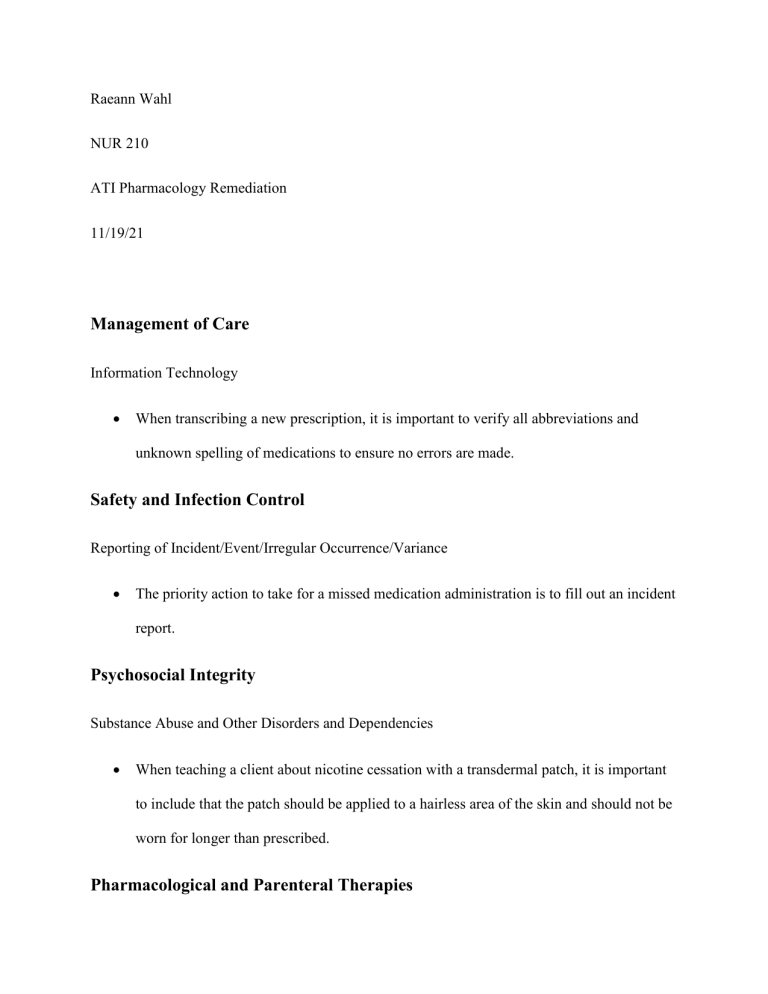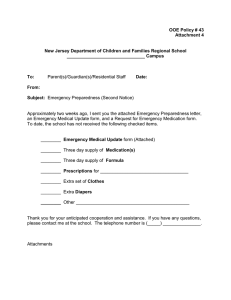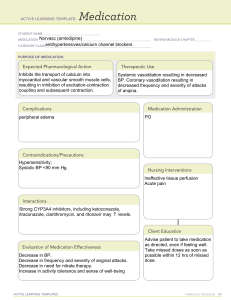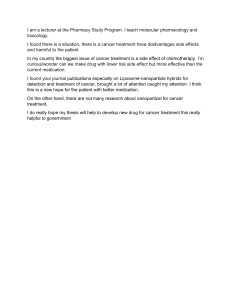
Raeann Wahl NUR 210 ATI Pharmacology Remediation 11/19/21 Management of Care Information Technology When transcribing a new prescription, it is important to verify all abbreviations and unknown spelling of medications to ensure no errors are made. Safety and Infection Control Reporting of Incident/Event/Irregular Occurrence/Variance The priority action to take for a missed medication administration is to fill out an incident report. Psychosocial Integrity Substance Abuse and Other Disorders and Dependencies When teaching a client about nicotine cessation with a transdermal patch, it is important to include that the patch should be applied to a hairless area of the skin and should not be worn for longer than prescribed. Pharmacological and Parenteral Therapies Adverse Effects/Contraindications/Side Effects/Interactions Manifestations of an allergic reaction include hyperkalemia, dysrhythmias, hypernatremia, and specifically dyspnea, rash, and pruritus with carbapenem reactions. Diuretics work to excrete excess water in the body which causes an increase in urinary output. The RN needs to notify the provider of adverse reactions to mannitol which include: heart failure, pulmonary edema, rebound increased intracranial pressure, fluid and electrolyte imbalances, and metabolic acidosis. Expected Actions/Outcomes The indications for administering epinephrine following administration of blood are anxiety, urticaria, wheezing, shock, cardiac arrest. Therapeutic effects of desmopressin include decreased urine volume and increased urine osmolarity. Therapeutic effects of filgrastim include decreased incidence of infection after receiving chemotherapy, radiation, or bone marrow transplantation. Medication Administration When administering nitroglycerin ointment, the nurse should apply to clean, hairless skin, cover with clear plastic wrap, and avoid touching ointment with the hands. The priority intervention for diabetic ketoacidosis is to administer fluid. The first action when mixing insulins in one syringe is to inject air into the cloudy insulin. Priority teaching about medication for type 2 diabetes mellitus include adhering to proper diet and physical activity. Titrating continuous nitroprusside include monitoring blood pressure and ECG for excessive hypotension and cyanide poisoning. The therapeutic level of INR is 2-3. Teaching that needs to be given to a new grad when administering heparin is the need to hold pressure on the injection site for 1-2 minutes after injection. Evaluating medication prescriptions include monitoring for improvement of pain, cough suppression, resolution of diarrhea, and reversal of respiratory depression. When completing a medication reconciliation the RN compiles a list of the client’s current medications then compare it with the new medication prescriptions and reconcile with the provider to resolve discrepancies. Pharmacological Pain Management The priority action when administering a controlled substance is to know the therapeutic effects of the drug versus the adverse effects and how to prevent and treat them. Reduction of Risk Potential Laboratory Values Laboratory values to report include excessive levels of antidepressants in the blood.





